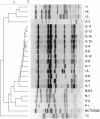ST9 MRSA strains carrying a variant of type IX SCCmec identified in the Thai community
- PMID: 23663295
- PMCID: PMC3658997
- DOI: 10.1186/1471-2334-13-214
ST9 MRSA strains carrying a variant of type IX SCCmec identified in the Thai community
Abstract
Background: Infections caused by methicillin-resistant Staphylococcus aureus (MRSA) in Thailand occur most frequently in healthcare facilities. However, reports of community-associated MRSA are limited.
Methods: We characterized 14 MRSA isolates from outpatients (O-1 to O-14) by phenotypic and genotypic methods and compared them with 5 isolates from inpatients (I-1 to I-5). Thai MRSA isolates from a healthcare worker (N-1) and a pig (P-1) were also included as ST9 MRSA strains from other sources.
Results: All MRSA isolates from the outpatients and inpatients were multidrug-resistant (resistant to ≥3 classes of antimicrobials). All of them except strains O-2 and I-3 carried type III SCCmec and belonged to agrI, coagulase IV, spa type t037 or t233, which related to ST239. The strain O-2 (JCSC6690) carried type IX SCCmec and belonged to agrII, coagulaseXIc, spa type t337 and ST9, whereas the strain I-3 carried a type III SCCmec and belonged to ST1429. Nucleotide sequence determination revealed that the type IX SCCmec element in strain O-2 was distinct from that in a Thai ST398 strain (JCSC6943) previously identified in 2011; nucleotide identities of ccrA and ccrB were 93 and 91%, respectively and several open reading frames (ORFs) at the joining regions were different. PCR experiments suggested that strain O-2 and N-1 carried similar SCCmec element, whereas that of strain P-1 was different, suggesting that distinct ST9-MRSA-IX clones might be spreading in this province.
Conclusions: The SCCmecIX-ST9 MRSA clones of distinct SCCmec subtypes might have emerged in the Thai community and might also have disseminated into the hospital.
Figures


Similar articles
-
Molecular Characterization and Antimicrobial Resistance of Livestock-Associated Methicillin-Resistant Staphylococcus aureus Isolates from Pigs and Swine Workers in Central Thailand.Microb Drug Resist. 2019 Nov;25(9):1382-1389. doi: 10.1089/mdr.2019.0011. Epub 2019 Jul 30. Microb Drug Resist. 2019. PMID: 31361580
-
SCCmec IX in meticillin-resistant Staphylococcus aureus and meticillin-resistant coagulase-negative staphylococci from pigs and workers at pig farms in Khon Kaen, Thailand.J Med Microbiol. 2015 Sep;64(9):1087-1093. doi: 10.1099/jmm.0.000119. Epub 2015 Jun 30. J Med Microbiol. 2015. PMID: 26296763
-
Genetic diversity of methicillin resistant Staphylococcus aureus strains isolated from burn patients in Iran: ST239-SCCmec III/t037 emerges as the major clone.Microb Pathog. 2017 Apr;105:1-7. doi: 10.1016/j.micpath.2017.02.004. Epub 2017 Feb 5. Microb Pathog. 2017. PMID: 28179118
-
Genotype diversity of methicillin-resistant Staphylococcus aureus in Shenyang, China.Scand J Infect Dis. 2013 Dec;45(12):915-21. doi: 10.3109/00365548.2013.830330. Epub 2013 Sep 16. Scand J Infect Dis. 2013. PMID: 24032434
-
Livestock-associated meticillin-resistant Staphylococcus aureus in Asia: an emerging issue?Int J Antimicrob Agents. 2015 Apr;45(4):334-40. doi: 10.1016/j.ijantimicag.2014.12.007. Epub 2014 Dec 24. Int J Antimicrob Agents. 2015. PMID: 25593014 Review.
Cited by
-
Reducing the Risk of Transmission of Critical Antimicrobial Resistance Determinants From Contaminated Pork Products to Humans in South-East Asia.Front Microbiol. 2021 Jul 27;12:689015. doi: 10.3389/fmicb.2021.689015. eCollection 2021. Front Microbiol. 2021. PMID: 34385984 Free PMC article. Review.
-
Typing of staphylococcal cassette chromosome mec encoding methicillin resistance in Staphylococcus aureus isolates in Ahvaz, Iran.New Microbes New Infect. 2017 Nov 28;21:90-94. doi: 10.1016/j.nmni.2017.11.006. eCollection 2018 Jan. New Microbes New Infect. 2017. PMID: 29379604 Free PMC article.
-
Exploring the third-generation tetracycline resistance of multidrug-resistant livestock-associated methicillin-resistant Staphylococcus aureus ST9 across healthcare settings in China.J Antimicrob Chemother. 2023 Aug 2;78(8):1871-1881. doi: 10.1093/jac/dkad174. J Antimicrob Chemother. 2023. PMID: 37287125 Free PMC article.
-
Antimicrobial Resistance and Molecular Characterization of Methicillin-Resistant Staphylococcus aureus Isolated from Slaughtered Pigs and Pork in the Central Region of Thailand.Antibiotics (Basel). 2021 Feb 19;10(2):206. doi: 10.3390/antibiotics10020206. Antibiotics (Basel). 2021. PMID: 33669812 Free PMC article.
-
Novel Variants of SCCmec Type IX Identified in Clonal Complex 398 Livestock-Associated Methicillin-Resistant Staphylococcus aureus from Pork Production Systems in Korea.Antibiotics (Basel). 2025 Feb 21;14(3):217. doi: 10.3390/antibiotics14030217. Antibiotics (Basel). 2025. PMID: 40149029 Free PMC article.
References
-
- Katayama Y, Ito T, Hiramatsu K. Genetic organization of the chromosome region surrounding mecA in clinical staphylococcal strains: role of IS431-mediated mecI deletion in expression of resistance in mecA-carrying, low-level methicillin-resistant Staphylococcus haemolyticus. Antimicrob Agents Chemother. 2001;45(7):1955–1963. doi: 10.1128/AAC.45.7.1955-1963.2001. - DOI - PMC - PubMed
-
- Turlej A, Hryniewicz W, Empel J. Staphylococcal Cassette Chromosome mec (SCCmec) classification and typing methods: an overview. Pol J Microbiol. 2011;60(2):95–103. - PubMed
-
- Song JH, Hsueh PR, Chung DR, Ko KS, Kang CI, Peck KR, Yeom JS, Kim SW, Chang HH, Kim YS, Jung SI, Son JS, So TM, Lalitha MK, Yang Y, Huang SG, Wang H, Lu Q, Carlos CC, Pepera JA, Chiu CH, Liu JW, Chongthaleong A, Thamlikikul V, Van PH. Spread of methicillin-resistant Staphylococcus aureus between the community and the hospitals in Asian countries: an ANSORP study. J Antimicrob Chemother. 2011;66(5):1061–1069. doi: 10.1093/jac/dkr024. - DOI - PubMed
Publication types
MeSH terms
Substances
LinkOut - more resources
Full Text Sources
Other Literature Sources
Medical
Molecular Biology Databases

